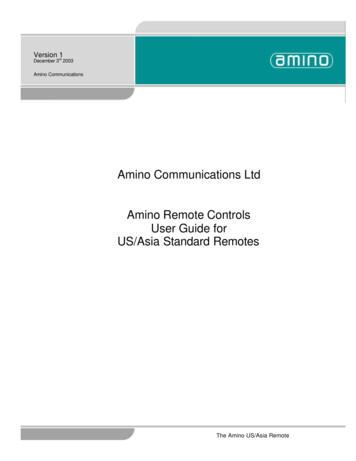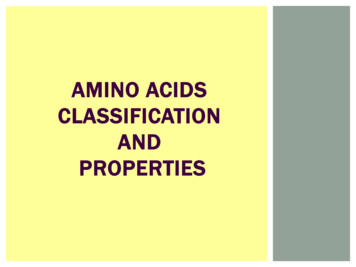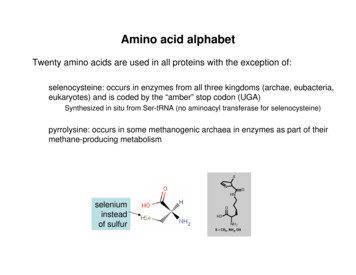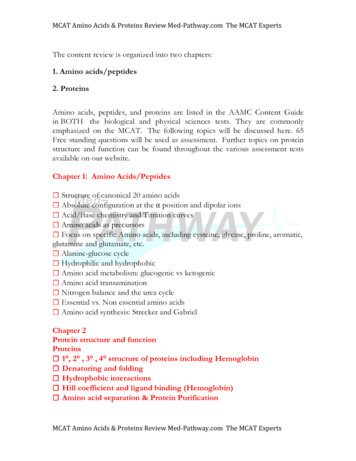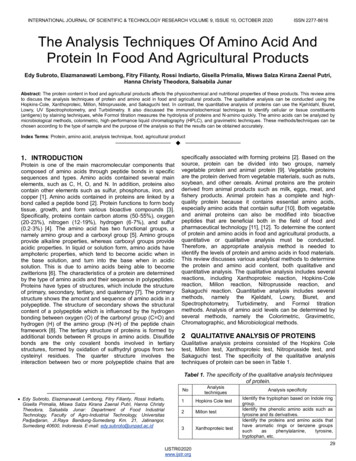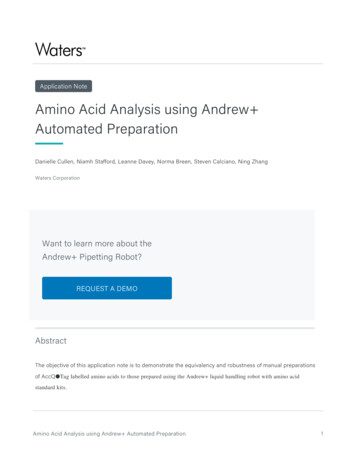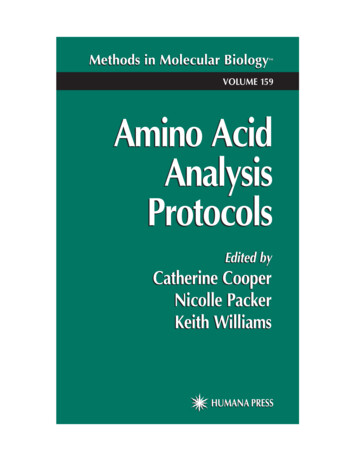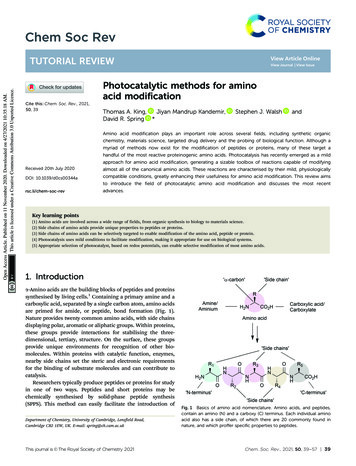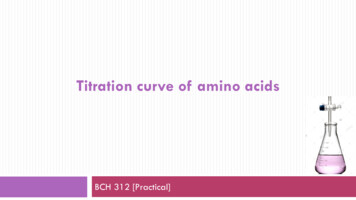![F][triazin-4-amino] Adenine C-Nucleoside For The Treatment Of Ebola And .](/img/14/ad1031184.jpg)
Transcription
TR-17-031 DISTRIBUTION STATEMENT A: Approved for public release; distribution is unlimited.Discovery and Synthesis of GS-5734, a Phosphoramidate Prodrug of a Pyrrolo[2,1f][triazin-4-amino] Adenine C-Nucleoside for the Treatment of Ebola and EmergingVirusesDustin Siegel1, Hon C. Hui1, Edward Doerffler1, Michael O. Clarke1, Kwon Chun1, Lijun Zhang1,Sean Neville1, Ernest Carra1, Willard Lew1, Bruce Ross1, Queenie Wang1, Lydia Wolfe1, RobertJordan1, Veronica Soloveva2, John Knox1, Jason Perry1, Michel Perron1, Kirsten M. Stray1, OnaBaraskaus1, Joy Y. Feng1, Yili Xu1, Gary Lee1, Arnold L. Rheingold3, Adrian S. Ray1, RoyBannister1, Robert Strickley1, Swami Swaminathan1, William A. Lee1, Sina Bavari2, TomasCihlar1, Michael K. Lo4, Travis K. Warren 2, and Richard L. Mackman1*1Gilead Sciences, Inc. Foster City, California, USA.2United States Army Medical Research Institute of Infectious Diseases (USAMRIID), Frederick,Maryland, USA. § USAMRIID Therapeutic Development Center (TDC), Frederick,Maryland, USA.3UC San Diego, San Diego, California, USA4Centers for Disease Control and Prevention, Atlanta, Georgia, USA.UNCLASSIFIED
TR-17-031 DISTRIBUTION STATEMENT A: Approved for public release; distribution is unlimited.ABSTRACTThe recent Ebola outbreak in West Africa was the largest recorded in history with over 28,000cases confirmed in Guinea, Liberia, and Sierra Leone resulting in 11,000 deaths including 500healthcare workers. This international crisis demonstrated the urgent need for a safe, effectiveand readily available treatment of Ebola infection. Multiple promising small molecule drugs andbiologics were rapidly pushed into clinical trials, including several nucleoside basedtherapeutics. From our nucleoside library, a focused screening effort identified a 1′-CN modifiedC-nucleoside 4 and a phosphoramidate prodrug mixture 4a, that demonstrated potent anti-EBOVactivity across multiple viral variants and cell lines in vitro (EC50 170 nM). Structure activityrelationships established that the 1′-CN group and C-linked nucleobase were critical both foroptimal anti-EBOV potency and anti-viral selectivity versus host polymerases. From a suite ofphosphoramidate prodrugs the 2-ethylbutyl alaninyl monophosphoramidate prodrug Sp isomerGS-5734, 4b was identified with anti-EBOV EC50 100 nM and broad spectrum activity towardseveral other families of RNA viruses. The Sp isomer was confirmed by X-Ray and thedevelopment of a robust and diastereoselective synthesis provided sufficient quantities of 4b toenable preclinical efficacy and safety studies. In a non-human primate EBOV challenge model,once-daily, 10 mg/kg i.v. treatment with 4b on days 3-14 post infection had a significant effecton viremia and mortality resulting in 100% survival of infected treated animals [Nature 2016,531, 381-385]. Phase 1 studies with 4b in normal human volunteers have been completed, andthe compound has been provided to two patients with confirmed Ebola infection undercompassionate use protocol. A phase 2 study (PREVAIL IV) is currently enrolling and willevaluate the effect of 4b on viral shedding from sanctuary sites in Ebola survivors.UNCLASSIFIED
TR-17-031 DISTRIBUTION STATEMENT A: Approved for public release; distribution is unlimited.Discovery and Synthesis of GS-5734, a Phosphoramidate Prodrug of a Pyrrolo[2,1f][triazin-4-amino] Adenine C-Nucleoside for the Treatment of Ebola and EmergingVirusesEbola Virus Disease (EVD) was first documented 40 years ago during an outbreak of infectioushemorrhagic fever in Northern Zaire (current Democratic Republic of Congo). More than 20intermittent outbreaks have occurred since then, but the most recent outbreak in West Africaspanning 2014-2016 has been the largest recorded in history and presented an internationalpublic health emergency.1 Over 28,000 cases were confirmed in Guinea, Liberia, and SierraLeone resulting in 11,000 deaths including 500 healthcare workers, which severely strainedthe local medical infrastructure.2 In survivors, the Ebola virus (EBOV) can persist in bodilyfluids for months after the onset of acute infection potentially leading to EVD-related sequelaeand viral recrudescence.3 While rare, secondary transmission has been documented to occurthrough sexual intercourse implicating persistent virus in genital secretions.4 Despite the end ofthe current outbreak, the potential for equally devastating future outbreaks, together with thepersistent virus observed in survivors makes the development of a safe, effective and readilyavailable treatment option for EVD a high priority.EBOV, a member of the Filoviridae family, is a single-stranded, negative-sense, non-segmentedRNA virus that is the causative agent of EVD. Other filoviridae family members includeMarburg, Sudan, and Bundibugyo viruses, which have all been responsible for outbreaksassociated with high mortality rates in sub-Saharan Africa.5,6 Over the course of the recent WestAfrican EVD outbreak, several direct acting anti-Ebola agents including monoclonal antibodies(ZMapp ),7 interfering-RNAs (TKM-Ebola,8,9 AVI-753710), and small moleculenucleoside(tide) antivirals such as favipiravir (1),11-13 and brincidofovir (2)14 have been evaluatedin early clinical trials (Figure 1). More recently another nucleoside analogue, galidesivir (3,BCX4430), has entered clinical development.15 These developments are encouraging but to date,none of these potential therapeutics have established robust clinical efficacy for the treatment ofacute infection or the viral persistence and sequelae. Several vaccines have shown strongpromise for preventing EBOV infection, but the breadth and durability of protection they canafford has yet to be established.16UNCLASSIFIED
TR-17-031 DISTRIBUTION STATEMENT A: Approved for public release; distribution is unlimited.Figure 1. Structures of antiviral nucleosides, nucleoside phosphonates and their prodrugs.NH2FNONOPOOOHHONH214NHHNNOOFavipiravir (1)OHNHONH2NH2NNNHONONNHOBrincidofovir (2)HOOHOH4Galidsivir (3)ONH2OONOHN P ONOONNHOOH4a Sp and Rp isomers (1:1)4b Sp isomer (GS-5734)OOOHN P OONONHOOONH2OHHOOOOHN PNNNNOOHOSofosbuvir (5)FTenofoviralafenamide fumarate(6)Prior to the Ebola outbreak, we had embarked on a strategic initiative aimed at evaluating thepotential of nucleoside analogs for the treatment of selected emerging viruses. A library of 1000 diverse nucleoside and nucleoside phosphonate analogs was harnessed from over twodecades of research across multiple antiviral programs. In collaboration with the Center forDisease Control and Prevention (CDC), and the United States Army Medical Research Instituteof Infectious Diseases (USAMRIID), selected compounds from the library were screened againstEBOV and identified parent 4 and a potent monophosphate prodrug mixture that contained theSp isomer GS-5734 (4b). This report describes in detail the structure activity relationships of theparent nucleoside, prodrug optimization and selection, and synthesis optimization of thedevelopment candidate 4b. Candidate compound 4b is currently in phase 2 trials to assess theeffect on the chronic shedding of virus in EVD survivors following promising efficacy dataestablished in a non-human primate EVD challenge model. These data have been recentlyreported17 and will be summarized along with the early clinical experience with 4b.UNCLASSIFIED
TR-17-031 DISTRIBUTION STATEMENT A: Approved for public release; distribution is unlimited.RESULTS AND DISCUSSIONThe assembly of the 1000 compound nucleos(t)ide screening library was heavily focusedtoward ribose analogs that could target RNA viruses since this would encompass many emergingviral infections ranging from respiratory pathogens belonging to the coronaviridae family suchas severe acute respiratory syndrome (SARS) / Middle East respiratory syndrome (MERS), tomosquito-borne viruses of the flaviviridae family such as Dengue and Zika. Second, the libraryalso contained selected monophosphate and nucleoside phosphonate prodrugs to capture analogsthat may be missed in cellular screens due to either poor permeability or inefficient metabolismin the respective cell types that the different antiviral assays utilize. Nucleoside analogs requireactivation by intracellular nucleoside/tide kinases to generate their respective triphosphate (TP)metabolites in order to then compete with endogenous natural nucleotide pools for incorporationinto the replicating viral RNA.17 The first phosphorylation step to generate the nucleosidemonophosphate, is often rate limiting so the application of monophosphate prodrugs, especiallyphosphoramidates (ProTidesTM) has been extensively explored in nucleoside analogs to bypassthis initial phosphorylation step.18 A notable example includes the phosphoramidate prodrugSofosbuvir (5) for the treatment of HCV.19 Nucleoside phosphonate analogs are bioisosteres ofthe monophosphates but also require prodrugs to enable masking of the charged phosphonateacid thereby allowing more efficient entry into cells. A recent example of an approved drug inthis class is the phosphonamidate prodrug tenofovir alafenamide (6) for the treatment of HIV.20In both examples the amidate prodrugs effectively deliver high levels of triphosphate(diphosphophosphonate in the case of nucleoside phosphonates) inside the target cells anddemonstrate significant improvements in potency compared to their respective parentnucleos(t)ides when screened in antiviral assays (Figure 1).20,21In the original library screening toward a panel of RNA viruses across different viral familiespromising leads were identified. Subsequent to the EVD outbreak, some of these analogs wereselected for EBOV testing in collaboration with the CDC and USAMRIID in a BSL-4 facility.From this screen nucleoside 422, a 1′-CN modified adenosine C-nucleoside discovered for HCVemerged with submicromolar activity towards EBOV in Human Lung Microvascular EndothelialCells HMVEC cells (entry 2, Table 1). In addition, its phosphoramidate prodrug mixture 4a23UNCLASSIFIED
TR-17-031 DISTRIBUTION STATEMENT A: Approved for public release; distribution is unlimited.containing 1:1 ratio of Sp (4b) (entry 3, Table 1) and Rp diastereoisomers was found to be verypotent toward EBOV in both Hela and HMVEC cells. Encouraged by these data, the anti-EBOVactivity for a range of nucleoside analogs and their prodrugs was evaluated and the results arereported in Table 1, along with activity toward respiratory syncytial virus (RSV), from thepneumoviridae family, and HCV, from the flaviviridae family.Table 1. Structure Activity Relationships (SAR) of nucleoside parents and selected prodrugs.NHOONH2NH2NH2NNNNHONONHONONH2OONOHN P 09aNH2NNNHONONHOOH11aEntryHONH2NOHN P 313aNOOOOHOH13bEBOV EC50EBOV EC50RSV EC50HCV 1b EC50CC50CC50CC50Hela cellsHMVEC cells3HEp-2 cellsHuh-7 cellsHEp-2 cellsHuh-7 cellsMT4 350.03820.15 0.0124 200.780.534.1 100 88 5734a0.170.120.0270.02329.21722.048-- 105.53893624.559---- 200 88 200 8812069a--3.91.16.9 100 44 32710--56 100 44 100 88 53811 50 107.312 100 44 57911a 20--632.5 100 4453 44-- 4432210NNONOHNOHN P ONOONFNOHN P OO112---- 100111350 10 100 44 100 44 571213a27132 500.37 50 441.41313b 2040 200.3195517.8196 well assay format. 2n 1 data only. 3HMVEC cells were TERT-immortalized human foreskin microvascular endothelial cells (ATCC-4025).The presence of the 1′-CN modification in 4 was found to be critical in providing selectivitytoward viral polymerases and avoiding the significant toxicity (CC50 0.01 – 0.15 µM) associatedwith the unmodified C-nucleoside 7 (entry 1).24 The MT4 cell line was also used, as a sensitiveUNCLASSIFIED
TR-17-031 DISTRIBUTION STATEMENT A: Approved for public release; distribution is unlimited.cell line to evaluate cytostatic effects of nucleoside analogs, and confirmed the poor selectivityof 7 observed in both the HEp-2 and Huh-7 cell lines. The prodrug mixture 4a in addition topotent anti-EBOV activity, demonstrated significant activity toward RSV and HCV, withpotencies similar or better than that for EBOV (EC50 120 nM). The broad and potent antiviralactivity across all three viruses for 4a was further supported by the potent activity of the singleSp isomer 4b toward other emerging RNA viruses such as MERS and Junin viruses, and to alesser extent Lassa.17 The 1′-methyl analog 8 (entry 4) was less active toward EBOV and alsodisplayed a higher degree of toxicity compared to the 1′-CN analog, illustrating how smallchanges in the polarity and size of the 1′ substituent can impact the overall profile. The 1′ethynyl analog 9 (entry 5)22 and its corresponding 2-ethylbutyl alanine prodrug 9a (entry 6) wereboth less active when compared to their respective 1′-CN counterparts. Compound 4 is a Cnucleoside analog which provides chemical and enzymatic stability toward deglycosylationreactions at the anomeric center. However, alternate base modifications including N-nucleosideswere also studied. Interestingly, the corresponding 1′-CN modified adenosine N-analog 10 (entry7)25 was significantly less active toward all viruses, whilst the 1′-CN modified N-nucleosidepyrimidine 11 (entry 8) retained some antiviral activity.26, 27 The phosphoramidate prodrug of 1′CN cytidine 11a (entry 9) did not improve the potency toward EBOV (in HeLa cell assay)presumably due to limitations in metabolism beyond the monophosphate. In general, thepotency trends of 1′ substitution and nucleobase changes were similar across EBOV, RSV andHCV which was in contrast to the trends uncovered with 2′ modifications. The 2′-deoxy-2′fluorine analog 12 (entry 10) and the 2′-β-methyl analog 13 (entry 11) both lacked significantantiviral activity. However, the 2′-β-methyl phosphoramidate prodrugs, analogs 13a and 13b(entries 12 and 13) respectively, were both potent toward HCV, and only weakly active/inactivetoward EBOV and RSV. This result suggests that HCV polymerase is more able toaccommodate the 2′-β-methyl group compared to the EBOV and RSV polymerases. Takentogether with the 1′ substitution and nucleobase SAR, the EBOV and RSV polymerasesdemonstrated similar activity trends, whilst HCV polymerase was differentiated in SAR at the 2′position.To interrogate the cell based SAR more rigorously the active nucleoside triphosphate (NTP)metabolite e.g. 4-TP23 was tested toward the viral polymerases. The triphosphate 4-TPUNCLASSIFIED
TR-17-031 DISTRIBUTION STATEMENT A: Approved for public release; distribution is unlimited.demonstrated a half-maximal inhibitory concentration of 1.1 µM against the RSV RdRp and 5.0µM against HCV RdRp (Table 2). The Ebola viral polymerase has to date evaded efforts towardits isolation and expression so the intrinsic activity of the active NTP metabolite cannot bedirectly evaluated. An alternate method for estimating the inhibitory properties of an NTP for itsviral target is to measure the NTP levels inside cells following incubation with the parent orprodrug compound at a given concentration, and then calculate the NTP levels at the EC50measured in the same cells. In a continuous 72-h incubation of 1 µM 4b the 4-TP concentrationsreached a Cmax of 300, 110, and 90 µM in macrophages, HMVEC, and Hela cells linesrespectively. When correlated to the EVD EC50s in these respective cell types (Table 1) a halfmaximal inhibitory concentration of approximately 5 µM was calculated for the intracellularinhibition of EBOV polymerase. This is several-fold weaker than the potency toward RSVpolymerase, but similar to HCV polymerase supporting the comparable antiviral EC50 datademonstrated for the prodrug mixture 4a across the three viruses when allowing for cell typedifferences (Table 1). The selective inhibition of the viral polymerases versus host polymerasesis considered a key factor in the development of a safe and effective nucleoside antiviral.28, 29Therefore the 4-TP was evaluated toward several host polymerases and was found to be a weakincorporator toward mtRNA Pol, and not a substrate for DNA pol γ, as would be expected giventhe presence of the ribose 2′ OH (Table 2). Across the host RNA and DNA polymerasesevaluated there was no inhibition up to 200 µM (Table 2) demonstrating a high degree ofselectivity of 4-TP toward the viral polymerases.Table 2. Inhibition of the RSV and HCV RdRps and human host polymerases by 4-TP.NH2NOOOO P O P O P OOOONONNHOOH4-TPEnzymeNTP IC50 (µM)NTP SNI1 rate(%)RSV RdRp1.1-HCV RdRp5-mtRNA Pol 2006UNCLASSIFIED
TR-17-031 DISTRIBUTION STATEMENT A: Approved for public release; distribution is unlimited.RNA Pol II 200-DNA Pol α 200-DNA Pol β 200-DNA Pol γ 20001SNI Single Nucleotide IncorporationMolecular structure information is not available for the EBOV or RSV polymerases so modelingof the active sites was performed based on the published structures for HIV and HCVpolymerases, together with an analysis of the respective sequences.30 Within the modeled activesite of EBOV polymerase the major difference between EBOV and RSV is Y636 (EBOV)compared to F704 (RSV) and the major difference between EBOV and HCV is E709 (EBOV)compared to S282 (HCV).31 On docking the triphosphate 4-TP, the 1′-CN group occupies apocket formed by residues that are identical between EBOV and RSV, yet very different in HCV(Figure 2a). Nevertheless the 1′-CN analog retains potency across these viruses. Moreover, the1′-CN analog should retain its potency across a wide range of filovirus polymerases that couldemerge in the future. The 2′-β-H of 4-TP is in close proximity to E709 and replacement of thisgroup with a 2′-β-methyl (compound 13 triphosphate) would be anticipated to interfere withE709 (Figure 2b). However, the 2′-β-methyl can be accommodated by the larger pocket affordedby the smaller S282 residue of HCV (Figure 2c). This suggests the lack of activity for 2′-βmethyl analogs toward EBOV and RSV and retained potency toward HCV is likely due to stericconstraints in the polymerase active site. Consistent with the model, EBOV and RSV both havethe E709 or equivalent residue, and compound 13 triphosphate was found to be significantly lessactive (IC50 30 µM) toward RSV (data not shown).Figure 2. (a) Compound 4-TP (green stick) modeled into EBOV polymerase active site.Residue Y636 is highlighted in green surface, sits below the ribose, and corresponds to F704 inRSV. Residue E709 is highlighted in red surface, sits in proximity to the 2′-β-H position of theribose, and corresponds to S282 in HCV; (b) compound 13-TP (green stick) modeled into theEBOV polymerase active site. The 2′-β-methyl overlaps with residue E709 highlighted in red.(c) Compound 13-TP modeled into the HCV polymerase active site. Residue S282 is highlightedin the yellow surface and the 2′-β-methyl can be accommodated.UNCLASSIFIED
TR-17-031 DISTRIBUTION STATEMENT A: Approved for public release; distribution is unlimited.NH2NH2NOOOO P O P O P OOOONONOOOO P O P O P OOOONNONNHOHOOHOH13-TP4-TP(a)N(b)(c)The screening and modeling efforts established 4 as the best lead for prodrug optimization. Theability to evaluate prodrugs, especially in vivo, required an efficient synthesis route for both theparent 4 and preferably single prodrug diastereoisomers. Neither was available at the outset sosignificant chemistry resources were applied to improve the robustness and scalability of theroute along with generation of single diastereoisomers. The first generation synthesis of 4 andthe single Sp phosphoramidate prodrug 4b commenced with a glycosylation reaction via metalhalogen exchange of the bromo-base 15 followed by addition into the ribolactone 14 (Scheme 1).Two conditions were identified to render this desired C-C bond formation. The first condition(a) proceeded through addition of excess n-BuLi to a mixture of TMSCl and 15, which wasdesigned to result in lithium-halogen exchange after removal of the acidic 6N protons by silylprotection. Addition of this in situ generated reagent to the ribolactone 14 then afforded 16 in25% yield.23,33,34 The alternative conditions (b) employed sodium hydride and 1,2bis(chlorodimethylsilyl)ethane for the 6N protection step, followed by lithium-halogenexchange, and addition to the lactone to afford 16 in 60% yield.22,35Scheme 1. First generation synthesis of 4a.aUNCLASSIFIED
TR-17-031 DISTRIBUTION STATEMENT A: Approved for public release; distribution is unlimited.NH2NH2NH2NNNNH2BnOOBnOO OBn14NN a or b BnONONcNBnOOOHNBrBnO15Chiral HPLCOOOONOHNONNOONNNHOOH4aOOfOOHN P ClNH2 HClOONHO4caOOH4NOHN P OONHOeNH2ONNNOHN P ONHOOBn17NH2OHN P OONBnOOBn16ONHOdNNH2OOH18a194bReagents and conditions: (a) n-BuLi, TMSCl, THF, 78 C, 25%; (b) 1,2-bis(chlorodimethylsilyl)ethane, NaH, n-BuLi, THF, 78 C, 60%; (c) TMSCN, BF3 Et2O, CH2Cl2, 78 C, 58% (89:11β-17/α). (d) BCl3, CH2Cl2, 78 C,74%. (e) 19, NMI, OP(OMe)3, 21%; (f) OP(OPh)Cl2, Et3N, CH2Cl2, 0 C, 23%.The efficiency of both conditions was suboptimal as the yields were capricious and highlydependent on the cryogenic temperatures and the rate of n-BuLi addition required for thetransformation. Furthermore, premature quenching and reduction of lithio base was observed,which was rationalized to be a consequence of deprotonation alpha to the lactone under thehighly basic conditions. Compound 16 was isolated as a mixture of 1′-isomers which were takeninto the subsequent 1′-cyanation reaction to isolate the major product, β-anomer 17, bychromatography.35 Following removal of the three benzyl protecting groups to afford 4, thediastereomeric mixture of the phosphoramidoyl chloridate prodrug moiety 19, was then coupledto provide 4a in 21% yield, as an 1:1 diastereomeric mixture.23 The two diastereomers wereresolved using chiral HPLC to afford the Sp isomer 4b and Rp isomer 4c respectively.36 Whilethis route initially provided quantities of 4b the variability in yields, suboptimal selectivity,frequent use of cryogenic temperatures, and chiral chromatography, hindered this route frombeing suited to larger scales.Scheme 2. Second generation synthesis of 4b.aUNCLASSIFIED
TR-17-031 DISTRIBUTION STATEMENT A: Approved for public release; distribution is unlimited.NH2NH2NH2NNNNH2BnOOON 4ONONOBn21OONOc17NH2OHN P ONNBnOOBnOe, fNOOHI14NNH2OHN P OhOOHN P OOONHONO2NO2OH22a22b4baReagents and conditions: (a) TMSCl, PhMgCl, i-PrMgCl LiCl, THF, 20 C, 40%; (b) TMSCN, TfOH, TMSOTf,CH2Cl2, 78 C, 85%; (c) BCl3, CH2Cl2, 20 C, 86%; (d) 2,2-dimethoxypropane, H2SO4, acetone, rt, 90%; (e)MgCl2, (i-Pr)2NEt, MeCN, 50 C, 70%; (f) 37% HCl, THF, rt, 69%. (g) OP(OPh)Cl2, Et3N, CH2Cl2, 78 C, then 4nitrophenol, Et3N, 0 C, 80%; (h) i-Pr2O, 39%.The second generation route enabled the diastereoselective synthesis of the single Spisomer 4b on scales suitable to advance the compound into preclinical efficacy and toxicitystudies (Scheme 2).17 The glycosylation step employed the iodo-base 20 instead of the bromobase which enabled a more facile metal-halogen exchange compatible with i-PrMgCl LiClcomplex.37 Treatment with PhMgCl and TMSCl provided 6N protection to remove the acidicprotons with a higher degree of control, and addition of i-PrMgCl LiCl followed by theribolactone 14 at 20 C afforded the glycosylation product 16 in a 40% yield. The milderreagents and temperature enabled large-scale batches to be carried out with consistent yields.Treatment of 16 with TMSCN, TMSOTf, and TfOH at 78 C afforded 17 in 85% yield in 95:5anomeric ratio. The inclusion of TfOH was key to promote the high yield and high selectivityfavoring the desired β-anomer. Benzyl deprotection was effected through treatment with BCl3and 4 was readily isolated through crystallization. Acetonide protection of the 2′,3′-hydroxylmoeities with 2,2-dimethoxypropane in the presence of H2SO4 afforded 21 in 90% yield.Utilizing the 2′,3′-acetonide protection was found to be optimal as the yield of the couplingreaction with the p-nitrophenolate 2-ethylbutyl-L-alaninate prodrug mixture 22a wasdramatically improved compared to directly coupling to the unprotected nucleoside 4 (70% vs40%). In the event, reaction of 21 with the single Sp isomer of the p-nitrophenolate prodrugprecursor 22b in the presence of MgCl2 and Hunig’s base efficiently appended the prodrug groupUNCLASSIFIED
TR-17-031 DISTRIBUTION STATEMENT A: Approved for public release; distribution is unlimited.in 70% yield as a single Sp isomer. Final deprotection of the acetonide with concentrated HCl inTHF afforded 4b in 69% yield.The single Sp isomer 22b of the p-nitrophenolate 2-ethylbutyl-L-alaninate prodrugprecursor 22a was prepared through a sequence beginning with exposure of 2-ethylbutyl-Lalanine 18 with OP(OPh)Cl2 followed by 4-nitrophenol to the diastereomeric mixture atphosphorus, 22a. Importantly, the single Sp isomer 22b was readily resolved from the mixture in39% yield through crystallization in diisopropyl ether, a discovery that was paramount for thesuccess of the diastereoselective synthesis of the 4b.38 Thus, utilizing the p-nitrophenolate 2ethylbutyl-L-alaninate prodrug coupling partner 22b offered a significant advantage over thechloridate 19 in the first generation sequence. Overall the second generation synthesis of 4boffered the following improvements: (1) milder glycosylation conditions at higher temperature toallow for consistent yields and scalability, (2) higher selectivity and yield for the 1′-cyanationreaction, and (3) a highly efficient coupling sequence of a single Sp prodrug moiety for thediastereoselective synthesis of 4b. Through this second generation route 200g was rapidlyprepared to support preclinical efficacy and toxicity studies.The stereochemistry of the p-nitrophenolate 2-ethylbutyl-L-alaninate prodrug 22b andcandidate compound 4b were unambiguously assigned by small molecule X-Ray crystallography(Figure 3). In both cases the Sp isomer was established and suggests that the coupling with thenucleoside and reagent follows a SN2 type inversion of the phosphorus stereocenter.Figure 3. Thermal ellipsoid representations of (a) 22b and (b) 4b.(a)(b)The improved method for preparing 4 enabled many monophosphoramidate (ProTideTM) andbisphosphoramide prodrug analogues to be synthesized, the results of which are summarized inUNCLASSIFIED
TR-17-031 DISTRIBUTION STATEMENT A: Approved for public release; distribution is unlimited.Scheme 3. A number of conditions were identified to affect the coupling of the prodrug moietiesto 4 or the 2′,3′-acetonide protected analogue 21. The reactions employing 4 proceeded undereither Brønsted basic conditions utilizing t-BuMgCl or Lewis acidic conditions with MgCl2 inpolar aprotic solvents to afford the desired prodrugs 4d-n in yields ranging from 24-43%. Thecoupling reaction of the 2′,3′-acetonide protected analogue 21 under lewis acidic conditionsfollowed by in-situ acetonide deprotection in general afforded much higher yields ranging from60-70% (analogue 4b and 4o). Both the para-nitrophenol (PNP) and penta-fluorophenol (PFP)prodrug electrophiles were compatible in the coupling reactions and achieved comparable yields.The reactions utilizing a 1:1 diastereomeric mixture of the prodrug electrophiles, 22a, d-i, k-mprovided the prodrug products in 1.5-2.6 to 1 diastereomeric ratios at phosphorus. In addition tothe monophosphoramidate prodrugs, two bisphosphoramide prodrugs 4p and 4q weresynthesized and evaluated since they avoided the preparation of chiral phosphorus reagents.Scheme 3. Prodrug Synthesis.NH2NH2NNHOONHONOorOOHOX P LGN4NOOHO22a-oNH2OR OONOONONHRX Aminoacid (AA)Ester (R)NOHN P O18bOH4a-o18a orNH2 HClNNO21ONOX P OO NNHONH2NNHOOH4p, R Et4q, R 2-EtBuProdrug1XEster RAA2LG3CouplingPartnerConditionsProductYieldIsomer Ratio22a2-EtBuL-AlaPNP4t-BuMgCl, THF, DMF, rt4a43%2.5 : 122b42-EtBuL-AlaPNP21MgCl2, (i-Pr)2NEt, THF, 50 C; conc. HCl, 0 C4b69%Sp Isomer22dEtL-PhePNP4t-BuMgCl, THF, DMF, rt4d34%2.6 : 1UNCLASSIFIED
TR-17-031 DISTRIBUTION STATEMENT A: Approved for public release; distribution is unlimited.22eEtL-ValPNP4t-BuMgCl, THF, NMP, rt4e43%1.8 : 122fEtAIBPNP4t-BuMgCl, THF, NMP, 50 C4f25%1.5 : 122gEtL-AlaPNP4t-BuMgCl, THF, NMP, rt4g24%2.5 :122hCH2c-PrL-AlaPNP4MgCl2, (i-Pr)2NEt, DMF, 50 C4h38%1.9 : 122ic-BuL-AlaPNP4MgCl2, (i-Pr)2NEt, DMF, 50 C4i37%3:2i-PrL-AlaPNP4t-BuMgCl, THF, NMP, 50 C4j38%Sp Isomer422j22kt-BuL-AlaPNP4MgCl2, (i-Pr)2NEt, DMF, 50 C4k32%1.5 : 122lCH2c-BuL-AlaPNP4t-BuMgCl, THF, DMF, rt4l36%1.7 : 122m3-PentL-AlaPNP4MgCl2, (i-Pr)2NEt, DMF, 50 C4m42%1.5 : 1522nc-PentL-AlaPFP4t-BuMgCl, THF, DMF, rt4n43%27 : 122o2-EtBuD-AlaPNP21MgCl2, (i-Pr)2NEt, THF, 50 C; conc. HCl, 0 C4o66%1.1 : 118bEtL-AlaNA4POCl3, PO(OMe)3, Et3N, rt4p16%NA18a2-EtBuL-AlaNA4POCl3, PO(OMe)3, Et3N, rt4q58%NA1Prodrug is an undetermined mixture of diastereoisomers unless otherwise indicated, 2 AA amino acid, 3 LG Leaving Group, 4Single Spisomers, 5Reagent was predominantly a single unassigned isomer at phosphorus, Ala Alanine, Phe Phenylalanine, AIB 2aminoisobutyrate, Et ethyl, cPr cyclopropyl, cBu cyclobutyl, cPent cyclopentyl, Pent pentyl, iPr isopropyl, tBu tert butyl, 2-EtBu 2-ethylbutyl, PNP para-nitrophenolate, PFP pentafluorophenolate, rt room temperature.The monophosphate prodrugs can improve the potency of the parent nucleosides substantially bydelivering the monophosphate into cells and effectively bypassing a rate limiting firstphosphorylation step. The phenol and amino acid esters mask the negative charge of the monophosphate group enabling facile passive penetration into the cell. The prodrug breakdown isinitiated by intracellular esterases (e.g. carboxy esterase 1, cathepsin A) that cleave the esterunraveling the carboxylate moiety, which then continues to breakdown to the monophosphatethat serves as the prescursor to synthesis of the intracellular NTP.17Prodrugs 4a-q were evaluated toward EBOV in three
Discovery and Synthesis of GS-5734, a Phosphoramidate Prodrug of a Pyrrolo[2,1-f][triazin-4-amino] Adenine C-Nucleoside for the Treatment of Ebola and Emerging Viruses . Dustin Siegel1, Hon C. Hui1, Edward Doerffler1, Michael O. Clarke1, Kwon Chun1, Lijun Zhang 1, Sean Neville1, Ernest Carra1, Willard Lew1, Bruce Ross1, Queenie Wang1, Lydia Wolfe1, Robert
